
- Phil
- September 15, 2025
Long-Distance vs Local Moves: Key Differences Explained
When it comes to moving, whether it’s across town or across the country, the process can feel overwhelming. But the reality is, local moves and long-distance moves differ significantly in terms of logistics, costs, and preparation. Understanding these differences is crucial to making an informed decision and ensuring that your move is as smooth and efficient as possible.
In this guide, we’ll explore the key distinctions between local and long-distance moves, from cost considerations to timelines, and offer insights on how to plan for each type effectively.
Understanding the Costs: Comparing Local vs Long-Distance Moves
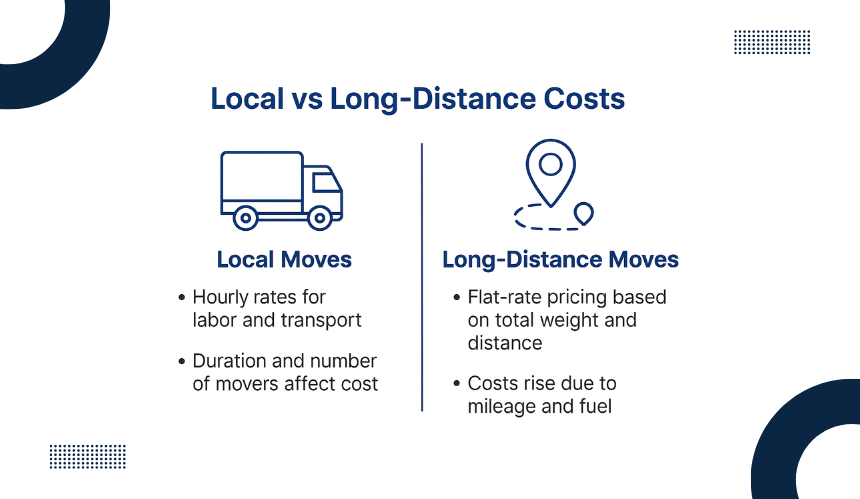
One of the most significant factors to consider when planning your move is the cost. Let’s break down the cost differences to help you budget accordingly and avoid any surprise expenses.
What are the Factors That Influence Moving Cost
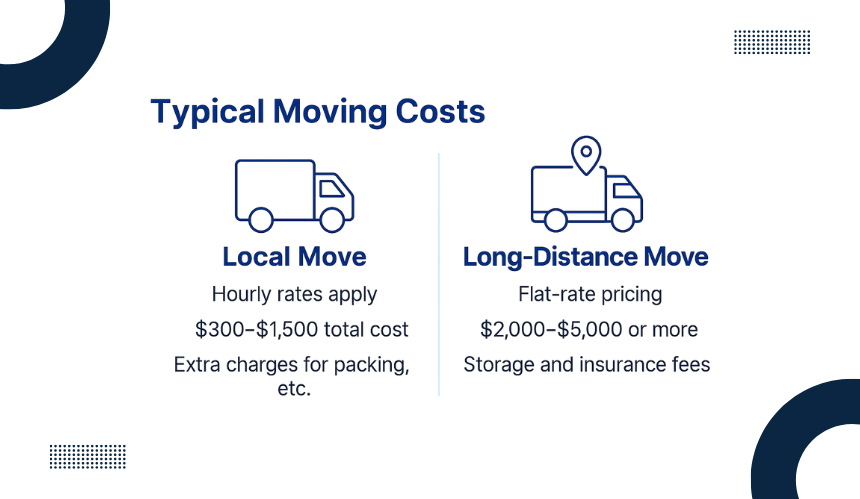
Both local and long-distance moves involve a variety of cost factors, but some elements weigh more heavily in one type of move than the other. For local moves, the most important factors include the time required for the move (usually charged on an hourly basis), the number of movers needed, and the amount of belongings to be transported.
For long-distance moves, the distance between the origin and destination is a major factor, in addition to the weight and volume of the items being moved.
- Local Moves: Typically, local moves involve hourly rates for labor and transportation. The cost can rise if the move takes longer than expected or if additional services, such as packing or furniture disassembly, are required.
- Long-Distance Moves: Here, moving companies usually offer flat-rate pricing based on the total weight of your items and the distance to be covered. The further you move, the more expensive the transportation costs become due to fuel, vehicle maintenance, and labor over longer distances.
How Much Does a Local Move Cost?
When it comes to local moves in Eugene, Oregon, understanding the cost breakdown is crucial for planning a smooth and budget-friendly relocation. The cost of a local move in Eugene typically ranges from $300 to $1,500, depending on the size of your move and the specific services you need.
- Hourly Rates: Local moving companies generally charge between $80 and $150 per hour. This includes two or three movers, depending on the size of the move. The time will vary based on factors like the accessibility of your current home.
- Additional Costs: You might encounter extra charges for packing materials, fuel surcharges, or moving special items like pianos or fragile antiques.
At A Great Moving Crew, a pack-and-move company based in Eugene, we offer an affordable and transparent rate of $55 per hour per mover, with a two-hour minimum.
Whether you’re relocating from a downtown apartment near the University of Oregon or moving from a more spacious home in the River Road area, our team ensures that you’re getting high-quality service at a price that fits your budget.
How Much Does a Long-Distance Move Cost?
Long-distance movers are typically more expensive, with average costs ranging from $2,000 to $5,000 or more, depending on the size of the move and the distance. Factors that influence these costs include:
- Distance: The further you’re moving, the more expensive the move becomes. Expect a rise in charges based on fuel costs, tolls, and the need for a larger moving vehicle.
- Weight of Items: The total weight of your items plays a significant role in the final cost. The heavier your load, the higher the cost, as long-distance movers base their fees on the total weight of the shipment.
- Additional Costs: Other charges may include temporary storage fees, insurance for the move, and potential overnight stays for movers during transit, especially if your destination is far.
Additional Fees & Hidden Costs
Both types of moves can come with additional fees, but long-distance moves tend to have more hidden costs due to the complexity of transporting goods over long distances. Some of the additional costs to look out for include:
- Packing Materials: Whether you’re moving locally or long-distance, you may need to purchase boxes, bubble wrap, and packing tape. For long-distance moves, specialized packing may also be necessary to protect fragile or valuable items during the journey.
- Insurance: Long-distance moves often involve more risk due to the extended travel time. Some moving companies offer insurance to cover the potential loss or damage of goods during the move. Make sure to evaluate the policy options and understand what’s covered.
- Storage: If your destination isn’t ready to receive your items immediately, you might incur extra costs for temporary storage, especially in long-distance moves where multiple days of transit may be involved.
Planning & Timeline: How Long Does Each Type of Move Take?
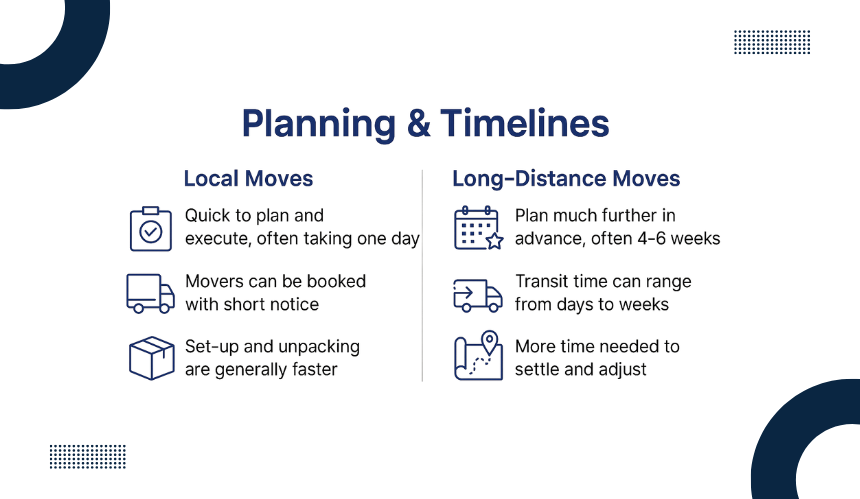
When it comes to moving, timing is everything. Whether you’re relocating locally or making a long-distance move, understanding the timeline for each type of move is crucial for ensuring everything runs smoothly. Here’s a look at how the timelines for local and long-distance moves differ.
How Much Time is Required for Local Moves
Local moves are typically quicker to plan and execute. Since the distance is shorter and the logistics are simpler, you can generally expect the entire process to take a few hours to a couple of days, depending on the size of your move.
- Planning Time: You can often plan a local move with as little as one to two weeks’ notice. However, the more time you give yourself, the better, as it allows you to book the right moving company and secure any necessary moving equipment or help.
- Move Duration: On moving day, the process is usually completed within a single day. A smaller apartment or home may take just a few hours, while a larger home may take up to 8 hours, depending on the number of movers and the volume of items.
- Post-Move Setup: Once you arrive at your new home, the setup process can take a few more hours or days, depending on how quickly you unpack and settle in. Since the move is local, you have the advantage of returning to your old place if you forget something.
How Much Time is Required for Long-Distance Moves
Long-distance moves require much more time, both for planning and execution. With more logistics involved and the need for transit across greater distances, long-distance moves can take anywhere from a few days to several weeks to complete.
- Planning Time: Planning for a long-distance move requires more lead time, often at least 4-6 weeks in advance. This allows you to obtain accurate moving quotes, secure the necessary services (such as storage or packing), and work around schedules for both you and the moving company.
- Move Duration: The transit time for a long-distance move can range from several days to a week or more, depending on the distance, the moving company’s schedule, and any potential delays. For example, a move from New York to California may take up to a week, including transit and unloading.
- Post-Move Setup: After reaching your destination, it can take longer to unpack and get settled, as you may be dealing with more items or a different space. Since long-distance moves are often accompanied by delays or storage needs, your setup process may stretch out over a few days or even a week.
Factors That Affect Move Timeliness
Several factors can impact the overall timeline of both local and long-distance moves, including:
- Weather Conditions: Inclement weather can cause delays, especially for long-distance moves. Snowstorms, rain, or even extreme heat can affect transportation and unloading times. Always consider the weather forecast when planning your move, and be prepared for delays.
- Availability of Moving Companies: Whether you’re moving locally or long-distance, it’s important to book your movers well in advance. Local companies may have more flexibility, but for long-distance moves, availability can be limited during peak times like summer, holidays, or weekends.
- Seasonal Trends: Moving during peak season (May-August) can make it harder to secure your preferred moving date and may cause delays. Off-season moves may have more flexible timelines, but the trade-off is that you might have to deal with fewer available services.
- Complexity of the Move: Larger homes or moves involving special items (e.g., fragile furniture, antiques, or large appliances) may take longer to pack, load, and transport. Make sure to communicate the complexity of your move with the moving company for an accurate timeline.
How to Create a Moving Timeline Before Moving
Regardless of whether you’re moving locally or long-distance, creating a detailed moving timeline is key to staying organized and minimizing stress. Here’s a general overview of the steps to include in your moving timeline:
- 6-8 Weeks Before the Move: Finalize your moving company and services, get quotes, and start sorting and purging belongings. Begin researching your new area if you’re moving long-distance.
- 4-6 Weeks Before the Move: Start packing non-essential items. If you’re moving long-distance, this is a great time to arrange for any necessary storage or special packing.
- 2 Weeks Before the Move: Confirm all arrangements with your moving company, finalize your packing, and start disassembling large furniture or appliances.
- 1 Week Before the Move: Begin packing up your everyday items, label boxes, and prepare an essentials bag (clothes, toiletries, etc.). Double-check any special requirements for the move, such as permits or insurance.
- Moving Day: Ensure that all items are packed, the movers have access to your home, and you have all necessary paperwork in hand. For long-distance moves, this is when the movers will typically load your belongings onto a truck, while local moves may involve multiple trips.
Choosing the Right Moving Service: What to Look For
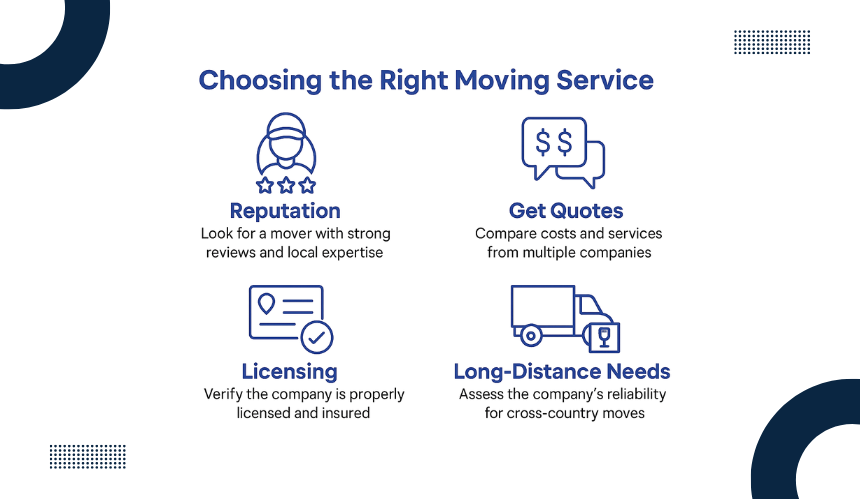
Selecting the right moving service is a crucial step in ensuring that your move goes smoothly. Here’s a guide to help you navigate the process and choose the best moving service for your needs.
Tips for Finding Reputable Local Movers
When choosing a local moving company, reputation and experience are key factors. Start by researching moving companies with a solid track record of serving your area.
Look for businesses that are highly rated across review platforms like Yelp and Google. Reading customer testimonials and asking for recommendations from friends or family can also help you find reliable movers in your region.
For example, in a city like Eugene, where neighborhoods like South Eugene or downtown can have narrow streets and unique logistics, it’s important to select a company that knows the area well. Local knowledge ensures smoother, more efficient moves.
- Experience and Local Knowledge: A good local moving company will have intimate knowledge of the area, making it easier to navigate tricky parking situations, one-way streets, or local traffic patterns that could cause delays.
- Get Several Quotes: It’s always wise to obtain multiple quotes to compare pricing, service offerings, and availability. Most companies will offer free estimates that give you a better sense of what to expect cost-wise.
- Check for Licensing and Insurance: Make sure the moving company is fully licensed and insured. This provides peace of mind that your belongings are protected throughout the move.
How to Choose the Right Long-Distance Moving Services
For long-distance moves, choosing a company that specializes in such relocations is essential. Long-distance moves come with different challenges compared to local moves, such as extended travel times, cross-state regulations, and potential risks in transit. Here’s what to consider:
- Reliability: Look for a moving company with a proven track record of handling long-distance moves. They should be able to provide you with detailed timelines and offer support if any issues arise during transit.
- Transparent Pricing: Long-distance moves typically come with more complex pricing models. Be sure to get a clear, written estimate that includes all potential charges such as fuel surcharges, packing services, and potential delays.
- Insurance and Protection: Ensure the company offers adequate insurance coverage for your items during the long journey. This is especially important for valuable or fragile items.
At A Great Moving Crew, we are an Eugene-based moving company, offering both local and long-distance moving services. We ensure that, regardless of your destination, we can provide the professional support and expertise you need for both residential and commercial moves.
Best Practices for Preparing for a Local or Long-Distance Move
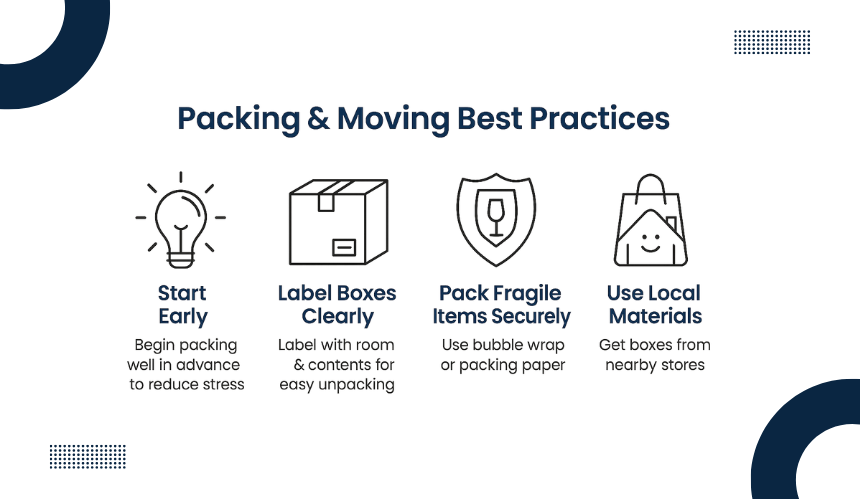
Following best practices while moving can help reduce stress, keep your move on track, and ensure your belongings arrive safely at their new destination. Here’s a guide to preparing for both types of moves effectively.
Packing for a Local Move: Best Practices for Packing Efficiently
When it comes to local moves in Eugene, the goal is to pack efficiently and avoid common pitfalls. Here are some best practices:
- Start Early: Even for a local move, don’t wait until the last minute to start packing. Begin by sorting through items you don’t need and donate or dispose of anything unnecessary. This will help you reduce the load and make packing more manageable.
- Label Boxes Clearly: Labeling your boxes with the room and contents will make it much easier to unpack once you arrive at your new home in Eugene. Consider color-coding boxes for each room to make unpacking more efficient.
- Pack Fragile Items Securely: For breakable items, such as glassware or electronics, use plenty of bubble wrap or packing paper to protect them. Consider using specialty boxes for fragile or awkwardly shaped items.
- Use Local Materials: If you don’t have packing materials, consider getting boxes from local stores in Eugene, which can be a cost-effective and sustainable option.
Packing Tips for a Long-Distance Move
Packing for a long-distance move, especially from Eugene to a distant location, requires more attention to detail to ensure your items survive the extended journey:
- Use High-Quality Packing Materials: For long-distance moves, it’s especially important to use high-quality packing materials, such as heavy-duty boxes and packing tape. Items that will be in transit for several days or weeks need extra protection.
- Disassemble Large Furniture: To maximize space and prevent damage, disassemble large furniture before the move. Label screws and bolts in a bag taped to the item for easy reassembly later.
- Trackable Services: When moving long-distance, opt for a moving service that offers tracking capabilities. This way, you can keep tabs on your belongings during transit, giving you peace of mind.
Organization & Logistics: How to Streamline the Process
A successful move requires careful organization and attention to logistics. Here’s how to streamline the process:
- Create an Inventory List: Take an inventory of all your items before packing. This list will help you keep track of your belongings and ensure nothing gets lost during the move.
- Plan Your Move Date: Be sure to schedule your move well in advance, particularly for long-distance moves. If you’re moving locally in Eugene, you might have more flexibility, but it’s still wise to plan ahead to secure the best moving crew.
How to Prepare for Moving Day
The day before your move is crucial for making sure everything is packed and ready to go. Here’s what you should do:
- Day Before: Finish packing all but the essentials. Set aside a bag with personal items you’ll need during the move, such as clothes, toiletries, and medications.
- Moving Day: Be sure to have everything ready by the time the movers arrive. Make sure pathways are clear for easy loading, and be prepared to give any last-minute instructions.
Frequently Asked Questions
How can I make sure my moving truck is equipped for icy or snowy roads?
Ask your movers if their trucks have winter tires, anti-lock braking systems, and weather-resistant ramps. Properly outfitted vehicles reduce the risk of delays or accidents on slick roads. You can also request photos or proof of maintenance for added peace of mind.
Is it better to move at night or early morning in bad weather?
Early mornings often provide clearer roads, better visibility, and less foot traffic. Scheduling your move at sunrise can help you avoid refreezing ice and allow more daylight for safe loading. This timing also gives you extra hours to dry off and settle into your new home before the evening.
What should I do if the moving day forecast changes at the last minute?
Stay in close contact with your movers and have a backup date or contingency plan ready. Some companies will hold a “weather window” slot that lets you shift your move by a few hours without extra fees. Keep essential items like clothes or toiletries separate so you’re prepared if the schedule shifts.
Are there eco-friendly waterproof packing options?
Yes. Biodegradable shrink wrap, compostable packing peanuts, and reusable plastic totes are increasingly available and perform well in rain or snow. Many of these products are durable enough to be reused for storage after the move, which cuts waste further.
How can I protect my home’s floors and entryways while moving during wet weather?
Lay down temporary floor coverings such as absorbent runners, carpet protection film, or even old towels. This prevents mud and water from damaging your flooring and keeps pathways safer for movers. Assign someone to check and replace wet coverings as needed to avoid slipping hazards.
Should I rent temporary climate-controlled storage during a winter move?
If there’s a gap between moving out and moving in, climate-controlled storage can keep sensitive items like artwork, electronics, and wooden furniture stable and dry. Look for facilities with covered loading bays or 24-hour access so you can move items in and out quickly.

